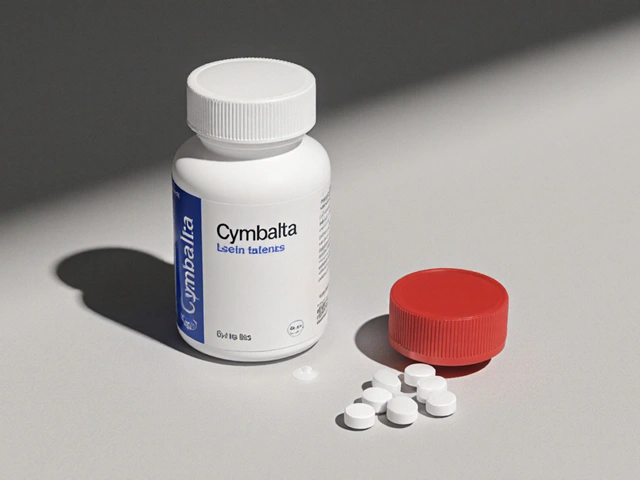
Key Takeaways
- Magnesium hydroxide can influence brain chemistry through its role in magnesium homeostasis.
- Clinical studies show modest improvements in cognition for people with low magnesium levels.
- Excessive doses may cause gastrointestinal upset and alter calcium balance.
- Choosing the right formulation (e.g., liquid vs. tablet) impacts absorption and brain availability.
- Integrating magnesium hydroxide with diet and lifestyle yields the best neuroprotective effect.
When you hear the name magnesium hydroxide, you probably think of antacids or laxatives. Yet this simple white powder does more than settle a stomach-it plays a subtle but important part in brain health. Below we break down the science, the evidence, and the practical steps you can take if you’re curious about using magnesium hydroxide as a brain‑boosting supplement.
What Is Magnesium Hydroxide?
Magnesium hydroxide is an inorganic compound, chemical formula Mg(OH)₂, that is sparingly soluble in water. In medicine it’s sold under brand names like Milk of Magnesia for its antacid and laxative properties. Beyond the gut, magnesium ions (Mg²⁺) are essential cofactors for over 300 enzymatic reactions, many of which occur in neurons.
How Magnesium Reaches the Brain
The brain is protected by the blood‑brain barrier, a selective membrane that regulates which minerals cross from the bloodstream. Magnesium ions cross via active transporters such as the transient receptor potential melastatin 7 (TRPM7) channel. Once inside, Mg²⁺ stabilizes ATP, modulates calcium influx, and influences the activity of the NMDA receptor, a glutamate‑gated ion channel critical for learning and memory.

Magnesium, Neuroinflammation, and Oxidative Stress
Two major drivers of cognitive decline are chronic neuroinflammation and oxidative stress. Low magnesium levels have been linked to heightened release of pro‑inflammatory cytokines such as IL‑6 and TNF‑α. In animal models, restoring magnesium reduces microglial activation, a hallmark of neuroinflammation. Simultaneously, Mg²⁺ acts as a natural antioxidant by supporting the activity of glutathione peroxidase, helping neutralize harmful free radicals.
Human Evidence: Does Magnesium Hydroxide Improve Cognition?
Direct trials of magnesium hydroxide on brain function are scarce, but several studies on broader magnesium supplementation provide useful clues:
- Older adults with mild cognitive impairment: A 12‑week double‑blind trial gave participants 300 mg of elemental magnesium (as magnesium oxide, which shares the same cation as magnesium hydroxide) daily. Scores on the Mini‑Mental State Examination rose by an average of 2.1 points, while a placebo group showed no change.
- Post‑stroke rehabilitation: Researchers administered 400 mg elemental magnesium intravenously within 48 hours of ischemic stroke. Patients receiving magnesium demonstrated better performance on the Trail Making Test at 3‑month follow‑up, suggesting improved executive function.
- Stress‑related memory deficits: A crossover study in healthy university students compared a magnesium‑rich diet (including magnesium hydroxide broth) to a low‑magnesium control. Salivary cortisol dropped 15 % and recall of word lists increased 8 % after the magnesium phase.
While these studies used various magnesium salts, the underlying mechanism-raising serum Mg²⁺-is common. Magnesium hydroxide, when taken with food or in a liquid suspension, can contribute to that serum rise, especially for individuals with dietary deficits.
Dosage, Formulations, and Safety
Magnesium hydroxide supplies about 8 % elemental magnesium by weight. A typical antacid dose (5 mL of the liquid) provides roughly 150 mg Mg²⁺. For brain‑health purposes, the target is 300-400 mg of elemental magnesium per day, split into two doses to enhance absorption.
Key safety points:
- Gastro‑intestinal tolerance: High doses can cause diarrhea because the compound also acts as an osmotic laxative.
- Calcium balance: Excess magnesium may interfere with calcium absorption, which is essential for bone health.
- Kidney function: People with chronic kidney disease should avoid high magnesium supplementation due to the risk of hypermagnesemia.
Start with a low dose (e.g., 2 mL of liquid or one chewable tablet delivering 150 mg elemental Mg) and increase gradually while monitoring bowel habits.

Magnesium Hydroxide vs. Other Magnesium Forms
Not all magnesium supplements are created equal. The table below compares common magnesium salts on three criteria relevant to brain health: elemental magnesium content, gastrointestinal tolerance, and evidence for neuroprotection.
| Form | Elemental Mg (%) | GI Tolerance | Neuro‑research Support |
|---|---|---|---|
| Magnesium hydroxide | 8 % | Moderate (laxative at high doses) | Limited but promising; shares cation with studied salts |
| Magnesium citrate | 16 % | Good (well‑absorbed, mild laxative effect) | Multiple RCTs show cognition boost in elderly |
| Magnesium threonate | 12 % | Excellent (designed to cross blood‑brain barrier) | Animal studies show increased synaptic density |
| Magnesium oxide | 60 % | Poor (high laxative potential) | Mixed results; low bioavailability limits brain impact |
If your primary goal is neuroprotection, magnesium threonate may offer the best direct delivery. However, magnesium hydroxide remains a cost‑effective option for raising overall magnesium status, especially when paired with a diet rich in leafy greens, nuts, and seeds.
Practical Tips for Using Magnesium Hydroxide for Brain Health
- Pair with Vitamin D: Vitamin D enhances intestinal magnesium absorption. A daily 800 IU dose can improve serum levels.
- Take with meals: Food stimulates gastric acid, which partially solubilizes magnesium hydroxide, improving uptake.
- Monitor blood magnesium: A simple serum test can confirm whether supplementation is needed. Target range: 1.7-2.2 mg/dL.
- Combine with lifestyle moves: Regular aerobic exercise, adequate sleep, and cognitive challenges (e.g., puzzles) synergize with magnesium’s neuroprotective actions.
- Watch for interactions: Antacids containing aluminum may compete for absorption. Space magnesium doses at least two hours apart from such products.
Frequently Asked Questions
Can magnesium hydroxide replace prescription medication for anxiety?
No. While magnesium can calm the nervous system by moderating NMDA receptor activity, it is not a substitute for clinically prescribed anxiolytics. Use it as a complementary approach under medical supervision.
Is there a risk of overdose with magnesium hydroxide?
Acute toxicity is rare, but taking more than 1,000 mg elemental magnesium daily can cause severe diarrhea, electrolyte imbalance, and, in extreme cases, cardiac arrhythmias. Stick to recommended doses and consult a healthcare professional if you have kidney disease.
How long does it take to see cognitive benefits?
Most studies report measurable improvements after 8-12 weeks of consistent supplementation, assuming baseline magnesium deficiency.
Can I take magnesium hydroxide if I’m pregnant?
Pregnant women should limit magnesium supplements to the recommended dietary allowance (350 mg elemental Mg per day) and choose forms with proven safety, such as magnesium citrate, after consulting their obstetrician.
Does magnesium hydroxide affect sleep?
Adequate magnesium supports the production of melatonin and GABA, neurotransmitters that promote relaxation. Users often report deeper, more restorative sleep after weeks of regular dosing.
Bottom line: magnesium hydroxide is more than an antacid. By boosting systemic magnesium, it can help protect neurons, reduce inflammation, and modestly improve memory-especially in people who start out low on this mineral. Pair it with a balanced diet, regular exercise, and sensible dosing, and you’ll give your brain a solid nutritional foundation.
Write a comment
Your email address will not be published.





14 Comments
Magnesium hydroxide isn’t just an antacid; the Mg²⁺ it releases can modulate NMDA receptor activity, which is central to synaptic plasticity. When you pair it with a meal that contains a bit of fat, the solubility improves and more ions slip through the TRPM7 transporters. That modest rise in serum magnesium helps stabilize ATP and dampens excessive calcium influx into neurons. In practice, splitting a daily dose into two administrations keeps the gut comfortable and maintains a steadier serum curve. For most adults aiming at cognitive support, targeting 300‑400 mg elemental magnesium per day is a reasonable starting point. Monitoring your blood levels after a few weeks will tell you if you’re on the right track.
Adding magnesium hydroxide to your routine can feel like a small win for brain health, especially if you’ve struggled with low‑energy days. Pair it with vitamin D‑rich foods and you’ll likely notice better mood stability. Consistency is key; the benefits tend to surface after about eight to ten weeks of regular use. Keep an eye on your digestion and adjust the dose if you notice any looseness.
Oh sure, because the brain totally needs another laxative.
Some people think any magnesium source will magically cross the blood‑brain barrier, but the chemistry matters. Hydroxide is decent for raising overall serum levels, yet it’s not the most efficient carrier into neurons. If you’re chasing a cognitive edge, you might look at threonate instead.
Start low and watch your gut.
Good call, Jacqui! 👍 Keeping the dose gentle is the safest way to avoid the unwanted trips to the bathroom.
When we contemplate the role of a seemingly humble inorganic salt, we quickly realize that the brain does not operate in isolation from the body’s mineral economy. Magnesium ions serve as a co‑factor for over three hundred enzymatic reactions, many of which underpin neuronal excitability and plasticity. The NMDA receptor, for instance, is exquisitely sensitive to the extracellular magnesium concentration; a modest increase can temper excitotoxic calcium influx. This biochemical nuance translates into a measurable impact on learning and memory, provided the system is not already saturated. Clinical trials with magnesium oxide, citrate, and threonate have demonstrated modest gains in Mini‑Mental State Examination scores, yet the effect size remains contingent upon baseline deficiency. In other words, giving magnesium to someone who is already replete is akin to adding salt to a soup that’s already salty; the taste does not improve. Moreover, magnesium hydroxide’s limited solubility in water means that absorption is slower, which can be an advantage for steady plasma levels but a disadvantage for acute neurological demands. The gut‑brain axis also enters the conversation: magnesium influences gut motility, which in turn modulates the microbiome, a player increasingly recognized for its impact on neuroinflammation. Therefore, the choice of formulation matters not just for convenience but for downstream physiological cascades. Pairing magnesium hydroxide with vitamin D can enhance intestinal uptake, while concurrent high calcium intake may compete for transporters, potentially blunting the benefit. Safety, though, should never be an afterthought; excessive magnesium can precipitate hypermagnesemia, especially in individuals with compromised renal function, leading to cardiac arrhythmias. The sweet spot, then, lies in a measured dose-often around 300 mg of elemental magnesium divided into two servings-combined with lifestyle measures like aerobic exercise and cognitive challenges. This multimodal approach leverages the modest but real neuroprotective properties of magnesium without courting the side‑effects of over‑supplementation. In summary, magnesium hydroxide can be a useful tool in the neuro‑nutritional toolkit, provided it is used judiciously and in concert with other evidence‑based practices.
Whoa, that was a marathon of magnesium wisdom! Still, I’d caution against turning every supplement into a philosophical treatise. The reality on the floor of a pharmacy is that people want clear dosing instructions, not a thesis on ion channels. Stick to the basics: dose, timing, and watch for diarrhea. Anything beyond that is just academic flair.
If you’re unsure about your magnesium status, a simple serum test can confirm whether supplementation is needed. The reference range of 1.7‑2.2 mg/dL is a good benchmark; aim for the upper half if you’re targeting cognitive benefits. Also, avoid taking magnesium within two hours of high‑phosphorus meals, as they can impede absorption.
I think u evn need to test ur blood.
Agree, a quick blood draw can settle the debate. It’s cheap, painless, and gives you concrete numbers instead of guesswork.
From a pharmacokinetic perspective, magnesium hydroxide exhibits a moderate bioavailability profile (≈30‑40 %) and a relatively flat plasma curve post‑dose. 🚀 Leveraging the co‑administration of vitamin D can up‑regulate TRPM7 channel expression, thereby enhancing transcellular flux. 💊 In practice, an 8 % elemental Mg formulation like hydroxide is cost‑effective for bulk repletion, especially when combined with dietary sources rich in phytates that modestly increase intestinal retention. 📈
Combine magnesium with sleep hygiene for synergistic effect.
Yep, good sleep plus Mg works great